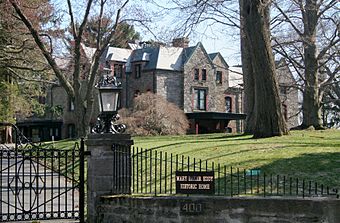Dupee Estate–Mary Baker Eddy Home facts for kids
Quick facts for kids |
|
|
Dupee Estate
|
|
 |
|
| Location | 400 Beacon Street Chestnut Hill Newton, Massachusetts |
|---|---|
| Area | 8.3 acres (34,000 m2) |
| Built | 1880–1881 |
| Architect | Peabody and Stearns |
| NRHP reference No. | 86001790 |
| Added to NRHP | September 4, 1986 |
The Dupee Estate is a large, historic house located in Newton, Massachusetts. It is famous for being the last home of Mary Baker Eddy. She was the founder of a religion called Christian Science. This beautiful estate is found in the village of Chestnut Hill.
Contents
About the Dupee Estate Property
The Dupee Estate is a big piece of land, about 8.3 acres. That's like having more than six football fields! On this land, there's a main house, a building that was once a gatehouse and carriage house, and two smaller buildings.
The Main House: A Historic Home
The main house was built a long time ago, between 1880 and 1881. It was designed by famous architects named Peabody and Stearns. People describe its style as "Ruskinian Gothic" or "Gothic, Stick/Eastlake." This means it has a grand, old-fashioned look with detailed wooden decorations.
The house has three floors and a basement. It has 25 rooms, which is a lot of space! The outside walls are made of strong stones like puddingstone, granite, and blue stone. The roof is made of black slate.
In 1907 and 1908, the house was updated. An architect named Solon Spencer Beman made changes to get it ready for Mary Baker Eddy to live there. He added two elevators and a new section to the house.
Other Buildings on the Estate
Besides the main house, there's a gate-carriage house that was built in 1892. This building was used for carriages and had a gate nearby. There is also a smaller garage on the property.
History of the Dupee Estate
The Dupee Estate has an interesting past, with different owners over the years.
Early Owners of the Estate
The main house was first built in 1880 for William Richardson Dupee. He was the original owner of this grand estate. In 1895, the Dupee family sold the property to R. Ashton Lawrence.
Mary Baker Eddy's Time at the Estate
Mary Baker Eddy bought the estate from R. Ashton Lawrence in October 1907. She moved into the house in 1908 after the updates were finished. This house was not just her home; it was also where she managed the church she had started. Mary Baker Eddy passed away in this house on December 3, 1910. She was buried in Mount Auburn Cemetery.
What Happened After Mary Baker Eddy?
After Mary Baker Eddy passed away, she left the estate to her church. For many years, the church kept the house just as she had left it. It was open for people to visit and learn about her life. However, keeping up such a large, old house became very expensive. The church decided to close it to the public.
In April 2006, the church announced they would sell the house. They wanted to focus more on their spiritual goals and less on managing properties. In December 2006, the Longyear Museum bought the house. This museum works to help people understand Mary Baker Eddy's life. They paid over $13 million for the property.
When the museum bought the house, the furniture and other items from Mary Baker Eddy's time were not included. The church removed them before the sale. However, in March 2007, Longyear Museum bought some furniture, rugs, and carriages that had been part of the estate. The museum hopes to get more of her personal items in the future.
Today, the Longyear Museum is working to fix and restore the house. They offer tours, but since many items were removed, they use photos to show how the house looked when Mary Baker Eddy lived there.
See also

